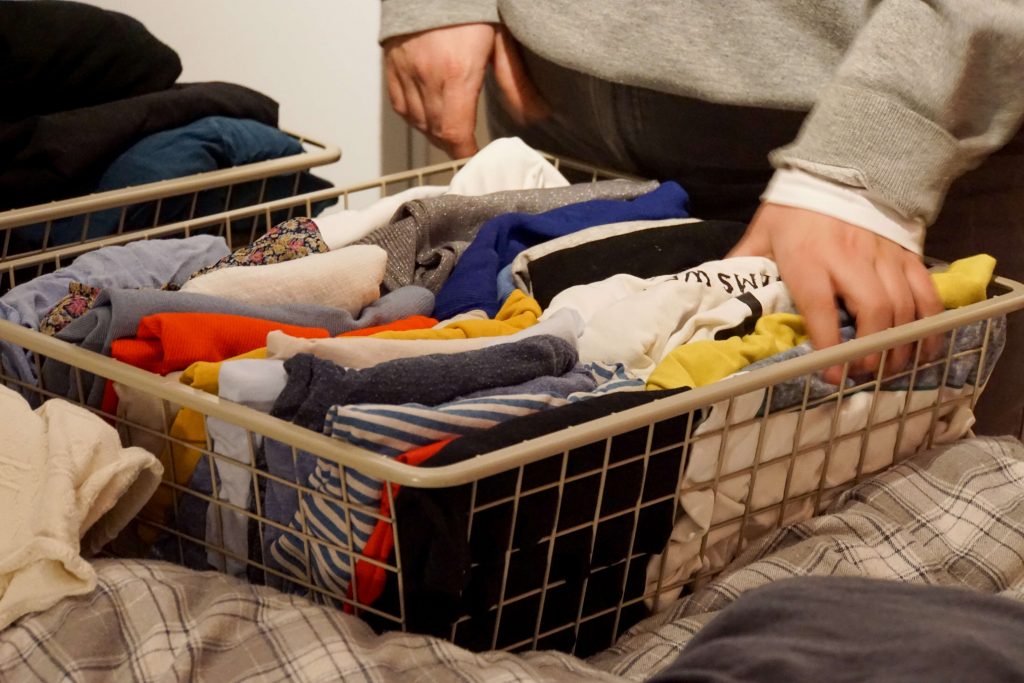Wardrobe inventories combined with inflow and outflow of garments in 15 Norwegian households
Vilde Haugrønning, PhD Candidate, Consumption Research Norway, Oslo Metropolitan University
My story of using wardrobe studies is based on the study I conduct as part of my PhD project, which is based in the CHANGE project. The aim of my PhD is to study how women’s and men’s clothing consumption in everyday life impact the material flow of garments in wardrobes and clothing volumes. The study is anchored in consumption studies and combines various methods that builds on the methodological approach of wardrobe studies. My project builds specifically on the hypothesis of the CHANGE project, which is that the specialisation of clothing for occasions and the expectations of variety are two aspects that are likely to have a big impact on the volume. To explore this hypothesis, the main objective is to study the constitutive elements of practice that influence clothing consumption and how this is influenced by gender.

The fieldwork is conducted in Norway and involves home visits to 15 Norwegian households with a man and a woman. Participants were recruited through various channels on social media and through personal networks. Potential participants were asked to fill out an online form and from this a sample of 15 households were selected. Since the overall perspective in this study is clothing consumption in everyday life, the participants were not recruited based on an interest in clothing or fashion, even though some had a stronger interest than others. The most important recruitment criteria were that the household consisted of a man and a woman, as the study aims to compare social constructs of gender. In addition, it was aimed to have a variety of informants in terms of age, occupation, location, and interests. The final sample consists of a variety of households from four different counties on Norway, from both urban and rural areas. Ages varies from late 20s to early 70s, some of the participants are retired, some live in houses and some in apartments, and some have children living at home.
The data collection has two phases and two visits in total to each household. The first phase involves a wardrobe inventory combined with a semi-structured interview. In this visit, two researchers, myself and my colleague Ingrid Haugsrud, are present. The participants are asked to count all the clothing they have access to, including underwear, socks and accessories but excluding shoes. The counting takes place with one participant at a time in front of their wardrobes, storage spaces or other places in the home where they store clothing. We use a template form to count the clothing based on garment categories and for each garment we ask what it is used for or what occasion it belongs to. After this, the counting form is transcribed and gives an overview of each participant’s wardrobes and its content. For example, the number of dresses for summer or number of trousers for the everyday.

The second phase starts at the end of the counting exercise, and the participants are asked to download an app that they will use to document inflow and outflow of garments for the next 6 months. This includes all the garments they acquire, make themselves or are gifted and garments that are donated or disposed of. The participants take photographs of the garments and upload them in the app, which also has a reminder function to keep them engaged. After 6 months, I conduct a final interview with the participants to talk about the garments they have documented.
The analysis and presentation of findings is yet to be done in my project, but the preliminary findings from phase 1 show that female participants have more clothing than male. By comparing the wardrobes and the different occasions attached to the garments, it is possible to see tendencies for why the women had more clothing. For example, several of the female informants have more clothing for everyday occasions and for party and formal occasions. Therefore, one of the reasons for the difference in the amount of clothing is likely to be related to the different expectations and conventions of gender roles in dressing for occasions and in varying between clothing for the same occasion.
From phase 2, I hope that the results can give insights into the dynamics of wardrobes from a volume perspective to better understand clothing quantities and the turnover rate of garments going in and out of wardrobes. For future research, I believe that doing a wardrobe study that involves a quantitative aspect, such as counting the whole or parts of the wardrobe, can give important insight to the content of wardrobes from a volume perspective. This could also be combined with a use frequency aspect, to investigate the connections between clothing quantities and the daily use of clothing.
As a final note, I would emphasise the data richness that wardrobe studies provide and the peculiarity of this way of doing field research, as people open up their wardrobes to complete strangers. There is something unique in being able to access people’s most intimate spaces through their clothing and hearing stories about good, bad and ordinary clothes.